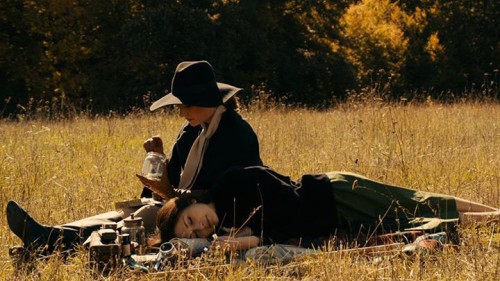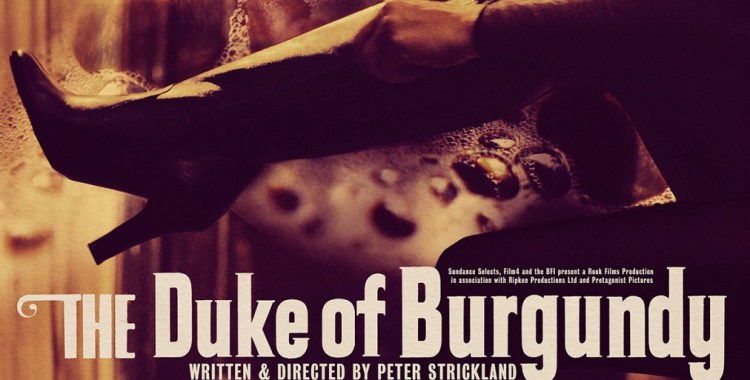Cynthia and Evelyn together
This guest post by Rushaa Louise Hamid appears as part of our theme week on Violent Women.
Note: The best viewing of The Duke of Burgundy is without any prior knowledge. Spoilers are contained throughout this piece.
Lesbian relationships in film often carry the burden of limited storytelling which focuses on coming out stories, pregnancy, affairs, and/or death. Peter Strickland’s The Duke of Burgundy has none of these traits. Rather it is a universal story about love and the ways in which we can be undone by it, exploring the emotional violence that can be carried by a relationship. Most importantly, unlike another film that shall not be named, The Duke of Burgundy highlights this as a failure of communication, not as an evil of kink itself. Evelyn (Chiara D’Anna) is neglectful, Cynthia is avoidant (Sidse Babett Knudsen), and these are aspects that can be found in all relationships.
In much of feminist literature from the past, kink is seen an act driven by patriarchy, with submissive women reproducing their oppressions in the bedroom and capitulating to gendered norms of women as silent and subservient. Even nowadays as the tide gradually changes, there is still a large amount of ire reserved for those who practice BDSM. Yasmin Alibhai-Brown writes in 2012, “When young women become instinctively assertive and free of gender constrictions, their liberty threatens the ‘natural’ order. So they have to be reminded of their place, taught they can never be good enough and must relearn submission.” Thus it is often hard to find films which explore serious issues in BDSM relationships without casting the assumption that the protagonists themselves are dis-empowered or damaged in some way.
The Duke of Burgundy in contrast demonstrates that submissive desires are not necessarily borne out of an instinct to please men and that acting in a role with limited power does not mean that a women actually has limited power in the relationship. In fact whilst the physical aspects of subservience we see in the film are consensual and empowering for Evelyn, it is Cynthia (the Domme) who suffers from emotional violence as both she and Evelyn accept the subordination of Cynthia’s own personal desires. This can sometimes be hard to recognise as quite as extreme as it is – indeed, in looking through reviews the level of the emotional conflict present is not addressed, instead viewed simply as lesbian love story with a kinky flair. In part this is perhaps due to the expectation that women perform the trope of martyr for love. The film though clearly presents that it is not the adopted role itself that determines the power balance within a relationship, but rather it comes about through the care of the individuals themselves.
The opening scene clouds this perception, deliberately obscuring who we can “root for.” We first see Evelyn approach the house, where she is aggressively greeted by a cold and cruel Cynthia. She is made to scrub floors and massage feet, eventually making an easily fixable mistake that results in the punishment of having her mouth urinated in. Without background information we assume that Evelyn is meek, and conforming to the past feminist conception of the submissive woman, and that Cynthia is controlled and sadistic. We are unsure throughout the scene of the degree of consent that is present. This is similar to the set-up for Secretary – of which The Duke of Burgundy has occasionally been described as the lesbian version of – where Mr. Grey belittles Lee before the two of them develop a romantic relationship; expectations have been put in place that this film will continue the cinematic trend of cold dominants learning to love. Yet once the scene cuts we see the two characters in bed together, Cynthia removing her wig and wanting to know if her performance was “too cold.”
Evelyn
We then get the opportunity to see the role-play from Cynthia’s perspective. We see her nervously preparing by guzzling water and frantically trying to memorise handwritten cards on which Evelyn has laid out every detail of the scene she wishes to enact. We see her struggling to maintain her icy composure, and suffering through back pain as she tries to maintain an upright posture. The violence is an illusion. Like the titular butterfly, Cynthia is mistaken for one type of person but is actually a completely different one.
In essence the film frames the physical act of “violence” and domination/submission as a representation of love and devotion; it is what the characters do because they want to share intimacy. This contrasts with the truer emotional violence – first with Evelyn’s increasing push of her kinks, wilfully ignoring the growing distress of Cynthia, then later with Cynthia’s violation of Evelyn’s safeword. Cynthia throughout takes on a “traditional” feminine obligation to provide support on things she is not comfortable with for love at the detriment of herself, suffering through the emotional trauma of a partner who increasingly ignores all her needs.
There are no men in this realm – everyone, down to the background characters (and even mannequins), are women. This is an interesting set-up, since even in this women-only world Cynthia cannot escape a gendered expectation of taking on the emotional burden of a relationship. On top of this, by divorcing the relationship from heterosexual narratives Strickland is allowing for more focus on Cynthia’s struggle as a dominant role-player since the character does not have to live up to the audience’s stereotype of the hyper-sexualised and commanding masculine ideal.
In a key scene, the emotional care of Cynthia contrasts with the selfishness of Evelyn. “Are you sure you’re going to be OK?” Cynthia asks having shut the heavy lid of the truck containing Evelyn tied up inside for the night. The silence panics her and so again she questions and is responded to with a sharp “Yes!” Cynthia’s legitimate need for a simple word of reassurance aren’t considered valid by her partner – instead there is an anger that Cynthia would dare break the fantasy role that Evelyn has placed her in.
Cynthia
Consent is a key aspect of BDSM, and is not just “no means no” or “yes means yes” but much more fluid and active – it requires partners to consider situations in which their lover might not feel comfortable or be physically able to speak out and so paying careful attention to body language is key. Evelyn is the true inflicter of violence in The Duke of Burgundy by ignoring these signs. If she was presented as a dominant man these acts of control would seem overt – pressuring her lover into a particular type of sexual activity, pressuring her lover to act in a particular way, pressuring her lover to dress in a particular way, ignoring her lover’s discomfort, using “I wasn’t getting what I wanted” to justify seeking things outside the relationship, and pressuring her to perform despite physical injury. Though Cynthia is making these choices too, she is also motivated by a fear that she will be abandoned if she refuses. Only in the end when Evelyn realises the sheer level of strain she has put her partner through (following Cynthia’s breakdown) does Cynthia get that reassurance that her no’s will not lead to Evelyn leaving her. Evelyn relies on Cynthia’s devotional love to continue to be egocentric and aggressive and ignores her responsibility to check in on her lover’s well-being.
In contrast to this slow drip of pressure from Evelyn, Cynthia expresses emotional violence all at once, choosing to violate their safeword on Evelyn’s birthday. The scene is aggressive and uncomfortable to sit through – by continuing through Evelyn’s cry of “pinastri” she has dragged Evelyn into a realm where her explicit consent no longer matters. Evelyn goes from a woman in charge of her sexuality to an object to be acted on, voiceless. “If only pinastri could make all our troubles go away,” Cynthia says as she presses onto her lover’s face, as if the only way the relationship can ever work is if one person is always suffering. Unfortunately this major violation is never addressed again in the film.
It is perhaps one of the best merits of The Duke of Burgundy that the resolution does not provide an escape from the duty to provide for love – rightly compromise is portrayed as an essential part of a relationship, and shifting the balance to entirely favour Cynthia would just leave the two cycling through the same mistakes and feelings of frustration. Though it is left ambiguous, with the closing scene featuring Cynthia back in her Domme persona, there is an element of confidence that these characters have learnt a little more about supporting each other. In Strickland’s world the true emotional violence is not defined as doing something you don’t want to do, but rather feeling trapped and ignored and unloved when doing something you have no interest in; it is about intent more than action. When Evelyn can grow and recognise the pain that she causes and Cynthia can articulate her needs they create a more tender relationship that can include the roles that each are willing to perform for the other, without carrying the emotional pain.
Rushaa Louise Hamid is a writer-for-hire normally located in London, UK. She enjoys politics, the issues of identity, and perfecting her Dalek impression. You can find her @thesecondrussia or more of her writing over at rulohamid.wordpress.com.

















